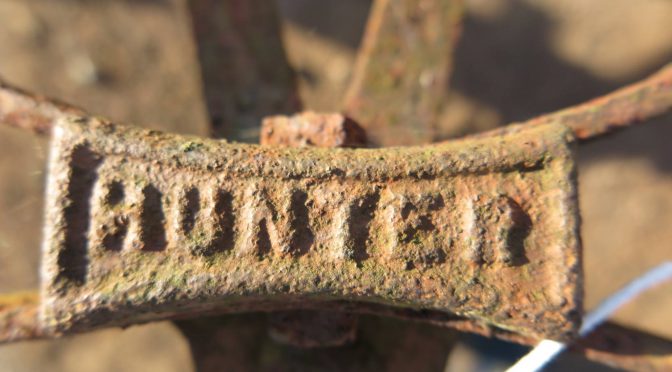A number of the Ayrshire implement and machine makers rose to prominence in Ayrshire, across Scotland and throughout the world for their manufactures. One of them was Thomas Hunter & Sons, Maybole.
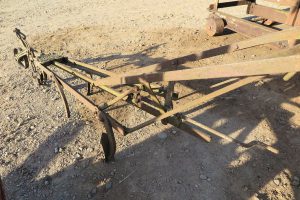 Thomas Hunter, a smith, in Maybole, announced his implements in the North British Agriculturist on 8 May 186. By 1883 his business had expanded so that he worked out of the Implement Works, Maybole. He was joined by his sons by 1895, renaming his business from Thomas Hunter to Thomas Hunter & Sons. That name was to continue until April 1914 when the company reorganised and became a company limited by guarantee: Thos. Hunter & Sons (Maybole) Ltd.
Thomas Hunter, a smith, in Maybole, announced his implements in the North British Agriculturist on 8 May 186. By 1883 his business had expanded so that he worked out of the Implement Works, Maybole. He was joined by his sons by 1895, renaming his business from Thomas Hunter to Thomas Hunter & Sons. That name was to continue until April 1914 when the company reorganised and became a company limited by guarantee: Thos. Hunter & Sons (Maybole) Ltd.
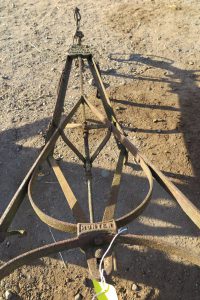 Thomas Hunter was an eminent agricultural engineer. In 1893 the North British Agriculturist provided a cameo of him. It states: “Mr Thomas Hunter, of Maybole, has long been one of the best known and most frequent exhibitors of all the leading agricultural shows, not only in Scotland, but also in England and Ireland. Since the death of the late Mr John Kemp, of Messrs Kemp & Nicholson, Stirling, Mr Hunter may be said to be the “father of the Scottish agricultural implement trade”. He was born in Maybole, and bred to the implement trade, which he learned with his father. At the age of sixteen years he set up a business on his own account in Liverpool, and exhibited on two occasions in the Haymarket, Liverpool, at the shows of the “Manchester and Liverpool”, which is now known as the Royal Liverpool, Manchester, and North Lancashire Agricultural Society. As showing the immense progress made by that Society, it may be mentioned that in these early days there were only about half a dozen exhibitors in the implement section at the show. On the death of his father, Mr Hunter returned to Maybole. Mr Hunter has been a regular exhibitor at the Highland Society’s shows for the last forty years, and for a good few of the first of these years his implement exhibits had all to be conveyed by carrier to Glasgow. The
Thomas Hunter was an eminent agricultural engineer. In 1893 the North British Agriculturist provided a cameo of him. It states: “Mr Thomas Hunter, of Maybole, has long been one of the best known and most frequent exhibitors of all the leading agricultural shows, not only in Scotland, but also in England and Ireland. Since the death of the late Mr John Kemp, of Messrs Kemp & Nicholson, Stirling, Mr Hunter may be said to be the “father of the Scottish agricultural implement trade”. He was born in Maybole, and bred to the implement trade, which he learned with his father. At the age of sixteen years he set up a business on his own account in Liverpool, and exhibited on two occasions in the Haymarket, Liverpool, at the shows of the “Manchester and Liverpool”, which is now known as the Royal Liverpool, Manchester, and North Lancashire Agricultural Society. As showing the immense progress made by that Society, it may be mentioned that in these early days there were only about half a dozen exhibitors in the implement section at the show. On the death of his father, Mr Hunter returned to Maybole. Mr Hunter has been a regular exhibitor at the Highland Society’s shows for the last forty years, and for a good few of the first of these years his implement exhibits had all to be conveyed by carrier to Glasgow. The 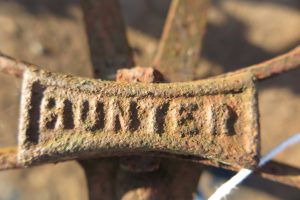 principal implements made by Mr Hunter are swing and chilled ploughs, the “triple drill” plough, which opens three drills at a time, and is largely used in the early potato districts; the “Hunter hoe and scarifier”, a most useful appliance in root and potato culture; the Hunter turnip raiser, another most useful implement for lifting the turnip crop, diagonal harrows, drag harrows, rollers, turnip slicers, sheep racks, &c. As showing the appreciation which Mr Hunter’s appliance shave met with at the hands of agriculturists, we may mention that he has been awarded more than 250 gold and silver medals and money prizes at the leading agricultural shows. No better testimonial as to the high quality and great usefulness of the appliances designed and manufactured by him could be desired than that furnished by the unique record which he can show of gold medals and other prizes awarded to his exhibits by the implement judges at the principal agricultural shows. Mr Hunter has an excellent business manner which peculiarly fits him for the work of an implement exhibitor, and in social life he is most genial and well-informed gentleman, whose society is always profitable and agreeable.” The company’s implements included a wide range of cultivating implements. In 1867 they included drill grubbers, horse hoes, drill harrows (for medium or heavy land), land rollers, zig zag harrows (for medium of heavy land), chain harrows (for medium or light land) and a plough with potato raiser. By 1867 the company was also making implements from other makers and patents. They included Tennant’s grubber, one of the most renowned implements of that time, and Dickson’s new patent double patent double drill turnip cleaner, another one.
principal implements made by Mr Hunter are swing and chilled ploughs, the “triple drill” plough, which opens three drills at a time, and is largely used in the early potato districts; the “Hunter hoe and scarifier”, a most useful appliance in root and potato culture; the Hunter turnip raiser, another most useful implement for lifting the turnip crop, diagonal harrows, drag harrows, rollers, turnip slicers, sheep racks, &c. As showing the appreciation which Mr Hunter’s appliance shave met with at the hands of agriculturists, we may mention that he has been awarded more than 250 gold and silver medals and money prizes at the leading agricultural shows. No better testimonial as to the high quality and great usefulness of the appliances designed and manufactured by him could be desired than that furnished by the unique record which he can show of gold medals and other prizes awarded to his exhibits by the implement judges at the principal agricultural shows. Mr Hunter has an excellent business manner which peculiarly fits him for the work of an implement exhibitor, and in social life he is most genial and well-informed gentleman, whose society is always profitable and agreeable.” The company’s implements included a wide range of cultivating implements. In 1867 they included drill grubbers, horse hoes, drill harrows (for medium or heavy land), land rollers, zig zag harrows (for medium of heavy land), chain harrows (for medium or light land) and a plough with potato raiser. By 1867 the company was also making implements from other makers and patents. They included Tennant’s grubber, one of the most renowned implements of that time, and Dickson’s new patent double patent double drill turnip cleaner, another one.
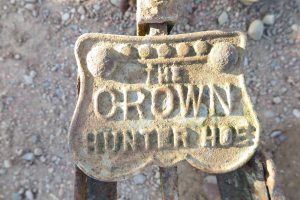 The company was also an early agent for a number of the renowned English (and also Scottish) makers. In 1871 they included Mellard & Co., Rugelet,and in 1875 W. N. Nicholson & Son, Newark on Trent (for hay makers), R. Tinkler, Penrith (noted churn maker) and G. W. Murray, Banff. By 1899 it was agent for other companies such as John Richardson, Carlisle, Plano Manufacturing Co., London, and J. & F. Howard, Bedford.
The company was also an early agent for a number of the renowned English (and also Scottish) makers. In 1871 they included Mellard & Co., Rugelet,and in 1875 W. N. Nicholson & Son, Newark on Trent (for hay makers), R. Tinkler, Penrith (noted churn maker) and G. W. Murray, Banff. By 1899 it was agent for other companies such as John Richardson, Carlisle, Plano Manufacturing Co., London, and J. & F. Howard, Bedford.
As noted by the North British Agriculturist, the company had numerous awards. Those from the Highland and Agricultural Society of Scotland, the national agricultural society, were especially important. They included a silver medal for two patent turnip thinners in 1873, a minor silver medal for its collection in 1875, and a first and second prize (with G. W. Murray & Co., Banff) for a turnip lifter in 1881. The company also entered a number of implements and machines for the Society’s trials, including its trial of seed cleaners (in 1882), a trial of turnip thinners (in 1883), a self-acting double-drill revolving turnip-thinner (in 1886), a trial of manure distributors (in 1894) and a trial of turnip lifters (in 1895).
The company passed a resolution to wind up on 30 May 1921. By 1924 the North British Agriculturist was advertising Hunter’s hoes, but the company was referred to as “Alexr Jack & Sons Ltd, Maybole, proprietors of Thomas Hunter & Sons (Maybole) Ltd. It continued to advertise in the North British Agriculturist until at last May 1934.
Some Hunter hoes bear both the Hunter name and a Jack name. The Hunter hoe secured Hunter’s legacy. A few Hunter hoes can still be seen around the rally fields. When you see one, think about the great legacy of the Hunter name in Scotland and around the world.
The photographs of the Hunter hoe were taken at the Scottish National Tractor Show, Lanark, September 2014.
